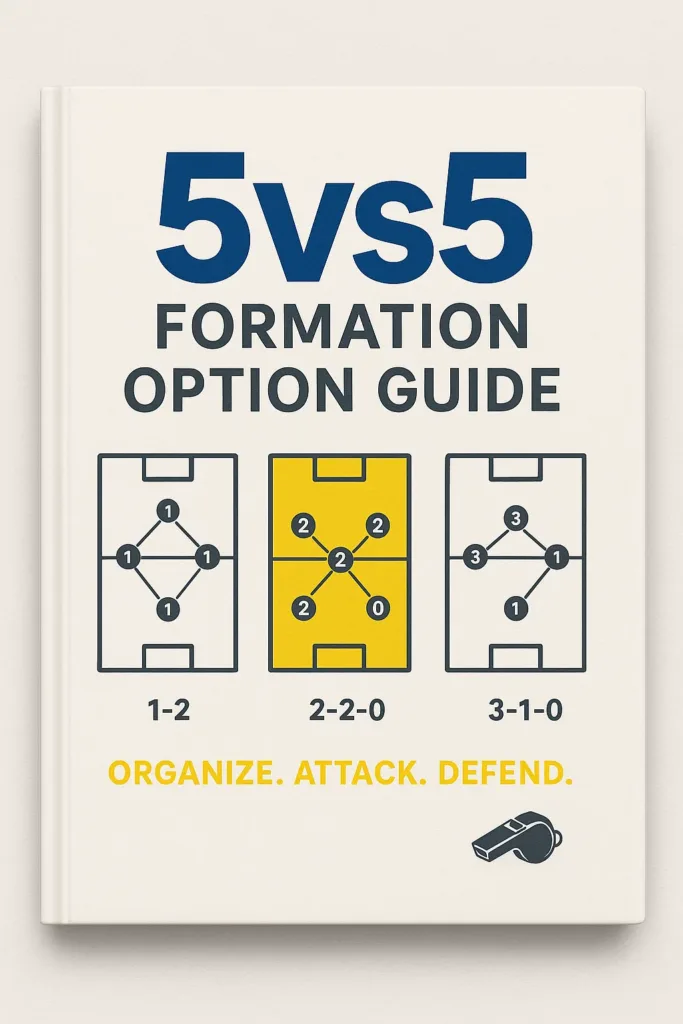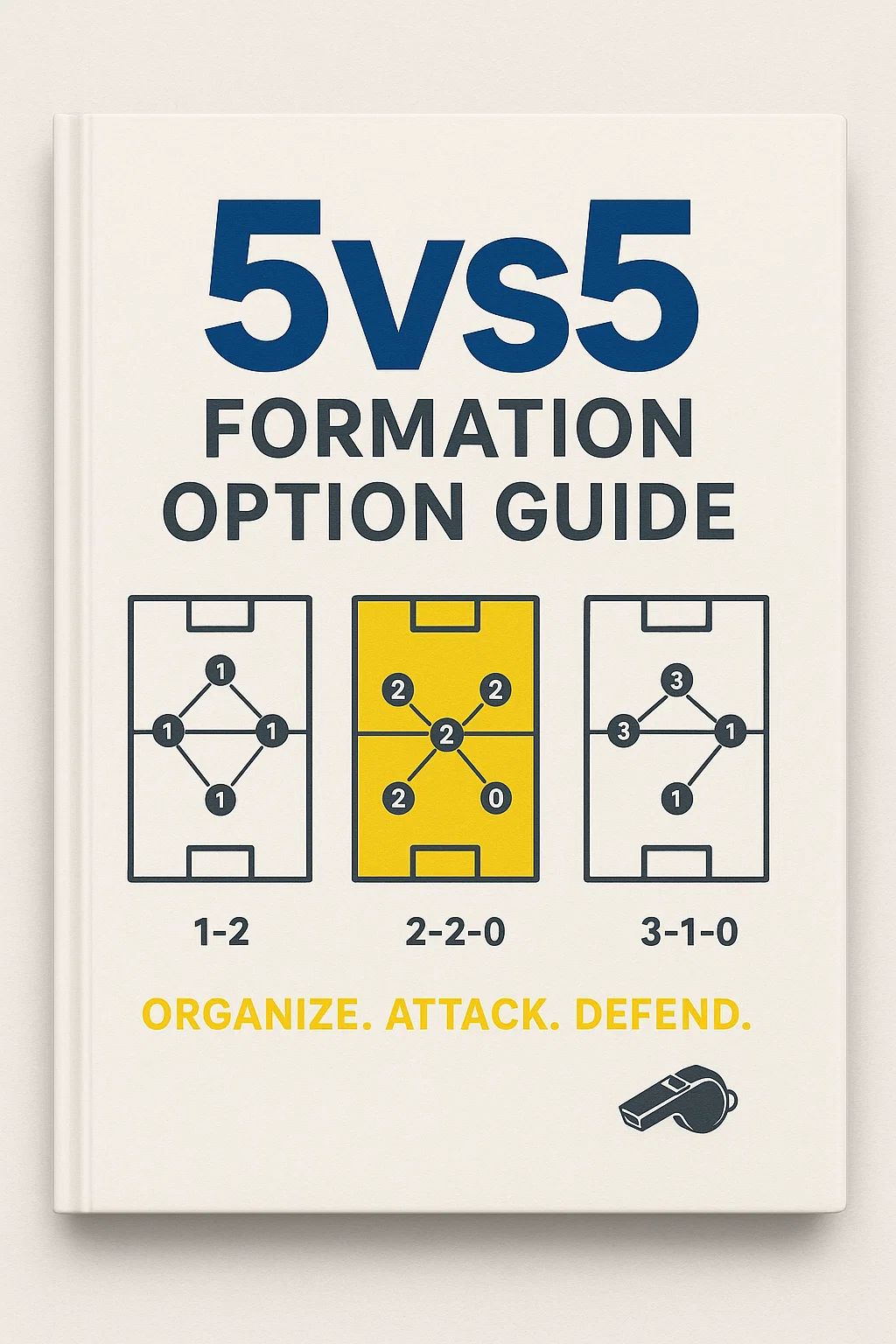5vs5 Formation Option Guide: The Microcosm of Tactical Mastery

5vs5 Formation Option Guide: The Microcosm of Tactical Mastery
Introduction: The Small-Sided Game as a Tactical Laboratory
In the vast and complex world of football tactics, the 5vs5 formation often gets overlooked in favor of its full-sided counterparts like the 4-3-3 or 3-5-2. However, this perspective fails to recognize the 5-a-side pitch for what it truly is: a concentrated tactical laboratory. The 5vs5 formation is not a simplified version of the game; it is a hyper-intensive microcosm where space is limited, decisions must be made in milliseconds, and every tactical concept is magnified. Mastering the intricacies of a 5vs5 formation is, therefore, one of the most effective ways to develop intelligent, technically proficient, and tactically astute players.
This guide is the definitive resource for understanding and implementing the various 5vs5 formation options. We will dissect the strategic strengths and weaknesses of different shapes, from the defensive solidity of the 2-1-1 to the attacking fluidity of the 1-2-1. This is not merely about placing players on a pitch; it is about instilling a deep understanding of principles that scale directly to the 11-a-side game. Drawing from the foundational principles in the UEFA B License Coaching Manual PDF and the advanced strategic concepts of the UEFA Pro License Course PDF, this guide will provide coaches and players with a complete 5vs5 formation option guide to dominate the small-sided game and accelerate overall football development.
Section 1: The Philosophical Foundation – Principles Over Formations
Before we explore specific formations, it is crucial to establish that a 5vs5 formation is a fluid framework, not a rigid structure. The small-sided game is the perfect environment to teach the non-negotiable principles that underpin all successful teams.
1.1 The Core Principles of 5-a-Side Football
The constraints of the 5-a-side pitch make the following principles even more critical than in the full game:
- Compactness: With less space, maintaining short distances between players is paramount. A compact unit is difficult to break down and allows for quick, short-passing combinations.
- Width and Depth: While the pitch is small, creating angles is everything. The formation must naturally provide width to stretch the opposition and depth to offer forward and backward passing options.
- Constant Movement and Rotation: Static players are easily marked. The best 5-a-side teams are in perpetual motion, rotating positions to create confusion and disrupt the opponent’s shape.
- Immediate Transition: The shift from attack to defense and vice-versa happens in an instant. A team’s reaction in the first three seconds after losing or gaining possession often decides the outcome of the game.
These principles are the true “formation,” and the player arrangements we will discuss are merely tools to facilitate them. This philosophy aligns with the player-centric approach championed by top academies, as seen in the Leicester City Football Club Academy PDF.
Section 2: Deconstructing the 5vs5 Formation Arsenal
Now, let’s delve into the specific 5vs5 formation options, analyzing their structure, strategic objectives, and the player profiles required for each.
2.1 The 2-1-1 (The Diamond) – The Balanced Foundation
This is arguably the most balanced and widely used 5vs5 formation. It provides a solid defensive base and a clear attacking structure.
- Structure: Two defenders at the back, one central midfielder, and one advanced striker.
- In Possession:
- The two defenders provide width and depth in the build-up.
- The central midfielder (the “pivot”) is the link player, responsible for receiving from the defenders and distributing to the striker or making penetrating runs.
- The striker’s role is to pin the opposition’s defenders, link play, and finish chances.
- Out of Possession:
- The shape naturally forms a compact defensive box, making it difficult for the opponent to play through the center.
- The two defenders must be disciplined, while the midfielder and striker initiate the press.
- Ideal Player Profiles:
- Defenders: Comfortable on the ball under pressure, with good passing range.
- Midfielder: A classic “box-to-box” player with high stamina, excellent vision, and the ability to shoot from distance.
- Striker: A clever player with good movement, a sharp first touch, and clinical finishing.
This formation is excellent for teaching the basic principles of play, which are explored in greater depth in the Principles of Play Attacking PDF.
2.2 The 1-2-1 (The Flat Four) – The Attacking Powerhouse
The 1-2-1 5vs5 formation is an aggressive, attack-minded system that prioritizes creating numerical superiorities in advanced areas.
- Structure: One dedicated defender, two midfielders/wingers, and one striker.
- In Possession:
- The single defender (often a “sweeper”) must be an exceptional distributor.
- The two midfielders have the freedom to operate in the half-spaces and wide areas, creating 2v1 situations against the opposition’s defenders.
- The striker and midfielders interchange positions constantly, creating a fluid, interchangeable front three.
- Out of Possession:
- This formation carries significant risk. It relies on a high press from the front three to force turnovers.
- The lone defender must be an elite 1v1 defender and have the pace to cover the space in behind.
- Ideal Player Profiles:
- Defender: A commanding, pacey, and technically gifted player—the team’s defensive linchpin.
- Midfielders: Creative, agile, and skilled in 1v1 situations. They are the primary chance-creators.
- Striker: A mobile and intelligent forward who can both finish and link play effectively.
This high-risk, high-reward approach echoes the philosophies of maverick coaches, aspects of which can be studied in Marcelo Bielsas Football Philosophy PDF.
2.3 The 2-0-2 (The Split Block) – The Transition Specialist
The 2-0-2 5vs5 formation is a direct and physically demanding system built for rapid transitions and exploiting space in behind the opposition.
- Structure: Two defenders and two attackers, with no dedicated central midfielder.
- In Possession:
- The defenders look to play direct, penetrating passes into the two strikers.
- The two strikers must work in tandem, making runs to stretch the defense and create channels for through balls.
- When in sustained possession, one defender may step into the midfield to create a temporary 2-1-1.
- Out of Possession:
- The team defends in a deep, compact 2-2 block, inviting pressure and looking to win the ball to launch counter-attacks.
- The two strikers are the first line of defense and must be ready to spring forward the moment possession is won.
- Ideal Player Profiles:
- Defenders: Strong in the tackle and capable of hitting accurate long passes.
- Strikers: Pace, power, and clinical finishing. They must be able to hold up the ball and run in behind.
This formation is excellent for practicing defensive shape and explosive attacking transitions, concepts that can be integrated into a broader The Training Plan.
Section 3: The Coach’s Handbook – Training for 5vs5 Success
Understanding the formations is only half the battle. The other half is training them effectively.
3.1 Session Design for 5vs5 Formations
Every training session should be designed to reinforce the principles of the chosen 5vs5 formation. A typical session, following structures from UEFA A Coaching Session Plans, might look like this:
- Warm-Up (10 mins): Use exercises from the Warm-Up Exercises with Ball PDF that incorporate passing patterns relevant to the session’s formation. For a 2-1-1 session, this could involve passing sequences between groups of two, one, and one.
- Positional Practice (15 mins): A 4v2 rondo in a defined shape, forcing the players to maintain their positional structure under pressure. This builds the muscle memory for the formation.
- Conditioned Game (20 mins): A 5vs5 game with a specific condition. For example, if working on the 1-2-1, a condition could be that a goal only counts if all three attacking players (the two midfielders and striker) have touched the ball in the build-up.
- Final Game (15 mins): A free 5vs5 game where the coach provides feedback related to the team’s shape and the session’s focus.
3.2 Using Conditioned Games from a Library of Drills
A resource like the 60 Training Games PDF is invaluable for a coach. You can select games that naturally encourage the behaviors of your chosen 5vs5 formation. For instance, a game that restricts players to two touches will encourage the quick circulation of the ball central to the 2-1-1, while a game that rewards goals scored within 5 seconds of winning the ball is perfect for the 2-0-2 formation.
Section 4: Advanced Concepts – Fluidity and In-Game Adaptations
The most successful 5-a-side teams are not slaves to their initial 5vs5 formation; they are masters of adaptation and fluidity.
4.1 Positional Rotation within a Structure
The 2-1-1 formation should not be static. The midfielder should sometimes make runs beyond the striker, who then drops into the midfield space. The defenders should feel comfortable stepping into midfield when the opportunity arises. This controlled rotation is what makes a team unpredictable and difficult to defend against. Teaching this requires a focus on player intelligence, a key outcome of advanced coaching education like the UEFA A Licence: The Complete Coach’s Guide PDF.
4.2 Tactical Fouling and Game Management
In a competitive 5vs5 environment, understanding when to commit a tactical foul to break up a dangerous counter-attack is a critical skill. Similarly, managing the game clock when leading—by retaining possession in the corner or forcing the opponent to play in certain areas—is a sophisticated tactic that can be practiced and perfected.
Section 5: Scaling Up – How 5vs5 Principles Translate to 11-a-Side
The ultimate value of mastering the 5vs5 formation lies in its direct application to the full-sized game.
- The 2-1-1 diamond teaches the roles and relationships within a 4-4-2 diamond midfield.
- The 1-2-1 structure is a microcosm of a 3-4-3 system, with the lone defender acting as the sweeper, the two midfielders as wing-backs, and the striker as the central forward.
- The principles of compactness, width, and immediate transition are universal. A player who understands how to create a 2v1 in a 5-a-side game will instinctively understand how to create an overload on the flank in an 11-a-side match.
This developmental pathway is a core focus of elite youth academies, as documented in resources like the Sheffield United F.C. U14 Academy and reinforced by the structured approaches found in the AFC B Diploma Coaching Course Certificate PDF.
Conclusion: The 5vs5 Formation as the Bedrock of Football Intelligence
This 5vs5 Formation Option Guide has journeyed from the philosophical foundations of the small-sided game to the intricate details of specific tactical shapes. We have seen that the 2-1-1 provides balance, the 1-2-1 offers attacking verve, and the 2-0-2 specializes in devastating transitions. However, the true lesson is that these formations are merely vehicles for teaching the timeless principles of football: spatial awareness, collective movement, and intelligent decision-making.
The confined space of the 5-a-side pitch is a relentless teacher. It punishes poor positioning and rewards clever movement. It is the perfect environment to implement the drills from Soccer Training Programs and to experiment with the concepts from the Essential 3-5-2 and 3-4-3 Training Exercises PDF on a smaller, more intense scale.
For the aspiring coach or player, mastery of the 5vs5 formation is not an optional extra; it is a fundamental pillar of development. By studying the principles outlined in this guide, and supplementing that knowledge with the wealth of information available in the linked internal resources and on renowned external platforms like The Coaches’ Voice and The FA’s Learning Platform, you can transform your understanding of the game.
Embrace the 5-a-side pitch. See it not as a smaller game, but as a clearer one. It is here, in this intensified tactical arena, that the footballing minds of tomorrow are forged. The formations are your tools; now go and build a team that is not only successful but also intelligent, fluid, and a true reflection of the beautiful game.New chat

